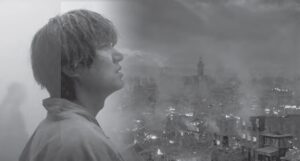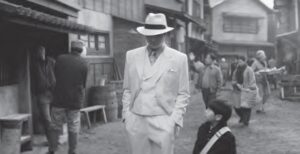Pachinko SEASON 1
By Showrunner Soo Hugh
Produced by Blue Marble Pictures, A.Han.Bok Dream Production
Media Res for the Apple TV+ streaming service
Based on the 2017 novel by Min Jin Lee
8 episodes, approximately 1 hour run time each
Color; Languages: Korean, Japanese, and English
(English subtitles available)
Available on Apple TV at https://tinyurl.com/4nbr494h
Reviewed by Jeffrey Wallace
In an overview of the Zainichi population of Japan, John Lie writes in his 2009 Education About Asia article “Zainichi: The Korean Diaspora in Japan”:
With Japan’s World War II defeat, the majority of ethnic Koreans left the Japanese archipelago (given the absence of official census, these numbers are rough estimates). In spite of suffering racial discrimination and economic exploitation, some 600,000 ethnic Koreans remained in Japan and constituted the Zainichi population (Zainichi means “residing in Japan” and can refer to non-Koreans, but the term has become synonymous with the ethnic Korean population in Japan). Some had achieved viable livelihoods, while others were weary of the unrest and poverty in the Korean peninsula. Risks of financial loss and political instability were far from the only reasons Koreans stayed in Japan. Many ethnic Koreans had married ethnic Japanese. Moreover, many ethnic Koreans born in Japan were linguistically and culturally Japanese. According to a 1951 study, 63 percent of Zainichi were born in Japan, and 43 percent of them could not speak Korean.
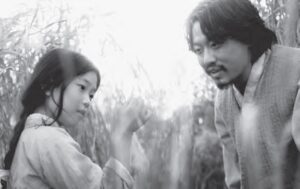
Min Jin Lee’s 2017 award-winning novel Pachinko, also discussed in the pages of EAA by both Charles Newell and Todd Munson, chronicles the story of a Zainichi Korean family over four generations, primarily through the life of the woman Sunja Kim, who faces intense discrimination and abuse when Korea is annexed by Japan in the early twentieth century and her later immigration to Japan. The family struggles as lowly regarded outsiders in a society that gives them little control of their own lives; whatever little success they have is often, much like the game of pachinko, through chance. Readers experience the turbulent history of events in Korea, Japan, and the US from 1910 to 1989 through the lives of Sunja, her family, and other acquaintances. The series has been adapted for television for the Apple TV+ streaming service, which readers can access for a nominal US $7 per month fee (with free trials of one month and sometimes longer) and will be available on DVD and Blu-Ray soon. This version, from showrunner (a person who oversees the production of a television series and its writers, directors, casting, etc.) Soo Hugh is very faithful to the novel, though with some key differences noted later. The writing, direction, cinematography, and performances are all superbly done. Viewers need not be familiar with or have read the book before watching the eight-episode series (each episode has an approximate runtime at or just under an hour).
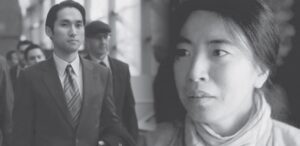
Before discussing the differences between the novel and the television series, here is a brief summary of the book without trying to spoil too much of the story.
Pachinko’s story is told across three time periods (called “books” in the novel): 1910–1933, 1939–1962, and 1962–1989. The three books are introduced with quotes from English novelist Charles Dickens, South Korean writer Park Wan-suh, and Irish political scientist and historian Benedict Anderson on important themes expressed in the book such as the bonds that connect families and communities together—including survival and shared trauma, identity, homeland, and belonging. Book I details the birth of Sunja and her life growing up in the fishing village of Yeongdo in Korea during Japan’s annexation of Korea in the early twentieth century, her complicated relationship with a Zainichi of wealth named Hansu, and her marriage to the ill Christian minister Baek Isak and subsequent migration to Osaka, Japan, where she lives with her sister-in-law Kyunghee, and Kyunghee’s husband, Yosef. There, Koreans are treated very poorly, forced to live in small ghettos and work menial jobs.
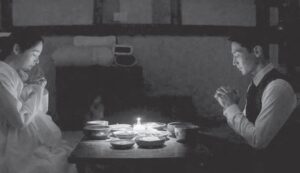
Book II jumps in time to an older Sunja raising her two sons, Noa (from her relationship with Hansu) and Mozasu (with Isak) in Osaka and struggling to make ends meet with Kyunghee. They make a meager living selling kimchi at a local market and eventually a local restaurant owned by Hansu as Japan enters World War II. During the war, Hansu arranges for Sunja and her family to work in Nagasaki at a factory for their protection before returning to Osaka, where Sunja’s sons resume their studies. Noa, with Hansu’s influence, succeeds in his studies and is accepted to prestigious Waseda University, but (without giving too much away) eventually drops out after learning about his heritage and disowns his family. Mozasu drops out of school and goes to work for a man who runs pachinko parlors—the gambling game similar to slot machines in the West but with tiny pinballs to play (a sizable, seedy gray market of pachinko games exists in Japan run by yakuza [Japanese-organized crime syndicates]). Of great importance for the television series, Mozasu meets a Korean seamstress named Yumi and they have a son together, Solomon, whom Mozasu must raise alone following Yumi’s untimely death.
Book III jumps further in time with a now elderly Sunja, still living in Japan, and her grown-up sons. Noa is now in hiding from his family and living undercover as a Japanese man while working as a bookkeeper for a racist pachinko parlor owner. Mozasu has become extremely wealthy due to the success of his owned pachinko parlors and is dating a Japanese woman named Etsuko with a troubled daughter from a prior marriage, Hana. Mozasu’s now-adult son Solomon eventually begins a relationship with Hana, but she soon runs away to Tokyo. Solomon goes on to study at Columbia University in the US and later takes a job in Japan with a British bank. Solomon, largely ignorant of his family’s history, is forced to confront this past when he is tasked with convincing an elderly Zainichi woman to sell her property to allow a golf course construction project to move forward, and a dying Hana reemerges in his life along with his grandmother, Sunja.
Pachinko is a deeply rich and poignant story that deftly touches upon several topics that in of themselves are worth pages of discussion—the Zainichi, Japan’s annexation of Korea, Christianity in Asia, World War II’s East Asia, among others. While it is a limited telling of this story,at least for now, the television series holds up to the book in telling the history of Sunja’s family and the plight of Zainichi living in Japan amid these historical events.
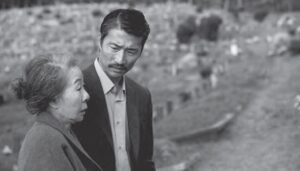
The biggest difference between the television series and the novel is its nonlinear storytelling. The novel proceeds in a linear manner from 1910 to 1989 as events unfold with the family, but the television series jumps back and forth from various points of the past to 1989 every episode. The television series tells its story primarily through the points of view of Sunja (played by three different actresses for her childhood, adulthood, and elderly years) from 1910 to 1989 and her grandson Solomon in 1989. Events are faithfully recreated from the novel, and the out-of-order storytelling creates a sense of mystery somewhat lacking in the novel. A common trope of TV, though lost in the “binge” era where viewers consume all episodes of a series at once, is teasing certain twists that viewers begin to connect episode to episode. For viewers unfamiliar with the novel, these twists will surprise viewers as the connections between time periods become more and more apparent. Episode 7, set amid the 1923 Great Kantō Earthquake, is certain to astonish even viewers who have read the novel.
Some other differences from the novel, occur such as the fate of Kyunghee, Sunja’s sister-in-law. Solomon dates a Korean–American woman named Phoebe in the novel, but this character is replaced in the television series by a different character, Naomi, with whom Solomon does not pursue a romantic relationship. The television series also is incomplete, but with good reason explained later. The events of World War II are not included, as the story focuses upon the 1910s–1930s and 1989. Sunja’s son Noa is completely absent in the story as well. However, these are most likely deliberate creative choices, as this is just the first season of the television series. Season 2 finished filming in early 2023 and will debut on the Apple TV+ service sometime in 2024. It is very likely that Noa, as well as the story set during World War II, will be featured in this second season. However, that is unknown, with very few details about this second season known (a trailer has yet to be shown). While the first season remained faithful to the events of the novel, it is always possible that season 2 could diverge more from Lee’s work.
Nevertheless, season 1 of the television series is a worthy adaptation of Min Jin Lee’s novel—a work quintessential for educators and students with an interest in Korea—that respects its source material. The novel and series are both recommended—although it is much harder to recommend the novel so as to not ruin the television series for those who hate possible spoilers for the upcoming season!
Additional Recommended Resources
As mentioned earlier, John Lie’s Education About Asia article “Zainichi: The Korean Diaspora in Japan” (https://tinyurl.com/9hhfeux3) is a superb backgrounder on the Zainichi. Christina Yi’s 2018 blog post on the Columbia University Press website, “On Min Jin Lee’s Pachinko and the Translation of ‘Zainichi,’” (https://tinyurl.com/ycxurdes) is a great discussion of the novel and the meaning of the Japanese term.
Specifically for the show, this Campus Connection blog post from July 2022 (https://tinyurl.com/2r3nsw79) is an excellent “one-stop shop” for educators who may wish to use portions of the show in class lessons. Synopses of the eight episodes are provided, as well as resources on several topics from the show, including this Korea Times article “1923 Kantō Earthquake Massacre Seen through American Viewpoints” by Robert Neff (https://tinyurl.com/yc6u835t), along with YouTube videos about the earthquake. The blog also features links for photographs of the Japanese occupation of Korea with background from Columbia University’s Asia for Educators program and a 2010 New York Times news story from then-Japanese Prime Minister Naoto Kan’s apology on Japan’s actions in South Korea during the colonial era (a very controversial and political topic). Justin McCurry’s “‘A Difficult Time’: Why Popular TV Series Pachinko Was Met with Silence in Japan” from The Guardian in April 2022 (https://tinyurl.com/me5vd3ej) helps explains these lingering controversies between Japan and South Korea.
Readers also receive background on Zainichi Koreans, pachinko with a YouTube video on the gambling game, context for why Koreans in the show were banned for wearing white by Japanese colonial authorities, the importance of Korean white rice, the significance of a wooden duck gift in the series, and the activity of neolttwigi (Korean seesaw) that is depicted in the show’s opening credits.
Excerpts from Charles Newell’s review of Pachinko in the Fall 2018 issue of EAA
Pachinko
By Min Jin Lee
New York: Grand Central
Publishing, 2017
512 pages, ISBN: 978-1455563920, Paperback
Pachinko, a game of chance not skill, is a rather curious Japanese amusement. It can best be described as a combination of pinball and a slot machine. Players purchase small silver balls that they drop or launch into the vertical pachinko machine. The balls bounce off pins and bumpers, and players hope the balls land in cups or slots that will win them prizes or money. However, the game usually ends with the balls dropping out the bottom of the machine, lost to the player forever.
Japanese–Koreans have a long and complicated history with their former colonial overlords. And in many ways, the game of pachinko is an accurate metaphor for their experience. Like the pachinko balls themselves, the many generations of the Korean family in the novel bounce off the pins and bumpers of life, without much say in the direction of their lives. Forces like colonization, World War II, wealthy gangsters, and a prejudiced Japanese society exert control over the characters’ fates. They are all left to circumstances beyond their control as they try to scratch out an existence in a country that sees Koreans as dirty criminals not worthy of any status in society. Even when some later generations of the family become wealthy and successful, they are never truly part of Japanese society. By the end of the novel, it becomes apparent why the pachinko business is run by Koreans. The Japanese themselves see it as a shadowy enterprise often linked to yakuza (gangsters). Thus, it is often the only place outsiders can find a toehold to earn a livelihood. . .
This book begins with the memorable phrase “History has failed us, but no matter.” This is true. The Zainichi living in Japan are a forgotten people. Lee shines a light on the struggles of a group of people that most of the world did not realize existed. However, this novel, like any great work of literature, goes beyond that narrow focus. The characters’ searches for love, success, and a sense of home and belonging are universal themes that transcend time and place. No one wants to be the pachinko ball that drops out of the bottom of the machine to be lost and forgotten by the rest of the world.
CHARLES NEWELL is an English Teacher at Baylor School in Chattanooga, Tennessee, and has published articles and curriculum materials on Korea. He is fascinated with Korean sijo poetry, and has videos on how to teach sijo in a high school classroom, published on the Sejong Cultural Society website.


